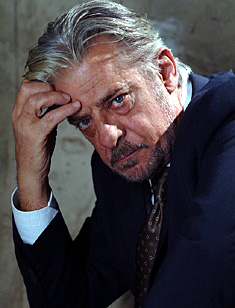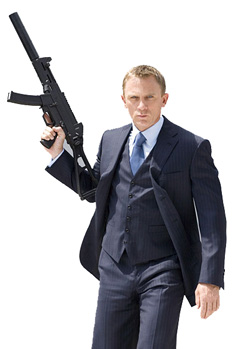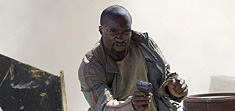|
The New Yorker
13/11/06
By ANTHONY LANE
Who said this: “It
is interesting for me to see this new Bond. Englishmen are so odd.
They are like a nest of Chinese boxes. It takes a very long time to
get to the center of them. When one gets there the result is
unrewarding, but the process is instructive and entertaining.” The
speaker is Mathis, a kindly French liaison officer in CASINO ROYALE,
Ian Fleming’s first James Bond novel, published in 1953. More than
half a century later, we are back with Casino Royale, No. 21
in the roster of official Bond films, and we are back with Mathis.
As played by Giancarlo Giannini, who was recently seen having his
intestines removed in Hannibal, he is pouchy, affable, and
dangerously wise, and his presence hints that this new adventure
will not be an occasion for silliness: no calendar girls, no
blundering boffins, no giants with dentures of steel. The same goes
for hardware, with rockets and gadgets alike being trimmed to the
minimum. It is true that Bond keeps a defibrillator in the glove
compartment of his Aston Martin, but, given the cholesterol levels
of the kind of people who drive Aston Martins, a heart-starter
presumably comes standard, like a wheel jack. Whether Bond has a
heart worth starting is another matter.

He is now played by
Daniel Craig, as the world knows, and, if I had my way, the world
would have shut up about it for the past thirteen months and waited
to see the result. Mathis was right: what we get is a Chinese box,
although one’s initial impression is that the outermost box is a
packing crate. I cannot prove it, but I suspect that God may have
designed Craig during a slightly ham-fisted attempt at woodworking.
His head is a rough cube, sawed and sanded, with the blue eyes
hammered in like nail heads. He could beat a man’s brains out with
his brow. That suits the Bond of Casino Royale, who has only
lately acquired his license to kill, and, like a kid who’s just
passed his driving test, is eager to step on the gas. He will slay
anyone, if he so wishes, and the news is that he does so wish, and
that he worries about the wishing—not enough to stop the killing,
although at one point he tenders his resignation to M (Judi Dench),
but enough to make him wonder if he’s fit for anything else. Craig
has the courage to present a hollow man, flooding the empty rooms
where his better nature should be with brutality and threat. His
smile is more frightening than his straight face, and he doesn’t
bother with the throwaway quips that were meant to endear us to the
other Bonds. The only thing he throws away is a set of car keys,
having borrowed a Range Rover and slammed it backward into a row of
parked cars, in order to set off their alarms. Calm down, you want
to tell him, have a Martini; and so he does. “Shaken or stirred?”
the barman inquires, and Bond spits back at him, “Do I look like I
give a damn?”
|
 |
The plot, unusually
for a Bond picture, leans heavily on the novel. Bond is up against
Le Chiffre (Mads Mikkelsen), who has a six-foot-tall mistress, a
weepy eye, and nothing to cry about. His pleasure is gambling, and
his career as a banker takes him to selected trouble spots, where he
likes to meet the locals and help them with their plans for
terrorism. What sets Le Chiffre apart from Bond’s preceding nemeses
is that he has absolutely no interest in running the planet,
preferring instead to profit nicely from its ruin. This is a welcome
twist, one of the pitiable things about the 007 franchise being its
fixation on global conquest—a cheesy homage, I often think, to the
ubiquity of the Bond brand itself. When Martin Campbell, the
director of Casino Royale, made GoldenEye, in 1995,
the outcome was spirited enough, but it also felt stupidly grand,
all wall-size computer screens and electromagnetic pulses fired from
space. The new film has a leaner streak, and the high-tech attack
methods are as follows: drowning your enemy in the washbasin of a
men’s room; throttling him in a hotel stairwell; and, best of all,
chasing him through a construction site.
This chase goes on
far longer than expected, like a theological discussion in a Bergman
film, with both the fleeing baddie and the pursuant Bond careening
off walls and cranes and anything else that juts into their path.
Rather than zipping through some customized hideout beneath the
waves, decked out with nuclear reactors and sharks, they are merely
making the best of their environment. Could this be something new in
movies: green violence? It looked pretty natural to me, with Bond
forever getting nicked and bruised. Casino Royaleis allegedly
the first 007 saga to feature rain, and Craig is the first proper
bleeder, standing in front of a bathroom mirror and contemplating
his own downpour. (Look how he swallows a Scotch to numb the hurt,
and then try to imagine the Roger Moore equivalent—the pensive sip,
the appreciative smile at the distiller’s art.) This is still Bond,
however, so the next scene finds him sliding into his seat at the
poker table, in a bloodless white shirt; indeed, if my math is
correct, he goes through three freshly ironed dress shirts in a
single night, which suggests that he has off-loaded Q in favor of a
silent Jeeves. Also, he has to look good for Vesper Lynd.
Miss Lynd is an
accountant, employed by Her Majesty’s Government, and, just as
The Spy Who Loved Me is said to have burnished the sales figures
for Lotus sports cars, so Casino Royale should transform
accountancy into the most erotically charged of the professions.
(There is one horrific attempt at product placement, and I hereby
propose an international ban on OMEGA watches.) Vesper is played by
Eva Green, who retains from her role in Bertolucci’s The Dreamers
an unnerving blend of the fleshly and the spectral, and one thing
she definitely is not is a Bond girl. Vesper is a Bond woman—a Bond
Lady of Shalott, I would say, with all the sufferings of the world
reflected in her dark-shadowed eyes. Her skin is paper-pale and her
lips are vampirically red, as if she hadn’t slept in a hundred
years, although, whatever has been keeping her awake, it isn’t sex.
She is the only woman with whom 007 partakes of coitus uninterruptus,
and even that takes two hours to bring off. For a Bond picture,
Casino Royale is amazingly short on lust. There is a moment when
our hero lands in the Bahamas and glances over his shoulder at a
couple of flirters in tennis gear, but Craig looks so embarrassed,
almost insulted, by such levity that the experiment is never
repeated. Bodies, it would seem, exist to be abused, not caressed,
and Campbell takes care to incorporate, straight from the novel, a
sequence in which Bond is denuded and tortured, with particular
attention being paid to his organs of desire. Poor fellow. If Pussy
Galore showed up, he’d pour her a saucer of milk. |
 |

Things have been so
moribund for so long in the Bond business that it was always going
to take some major defibrillation to jerk it back to life. Die
Another Day, the last film, was a gruelling nadir, although the
producers would be right to point out that it earned four hundred
and fifty million dollars, which is three times the purse that Bond
and Le Chiffre battle for at the tables. This means that the sight
of Pierce Brosnan driving an invisible car, though bound to dismay
every Bond-revering adult, was catnip to the larger constituency of
teen-age boys, who were comfortable with a film that felt like a
video game. What they will make of Casino Royale - no babes, no toyland, and the poker not even online
- is anyone’s guess, but the
earnings of the new film will doubtless affect the look, and the
casting, of the next. If Craig falters, then I guess it’s full speed
ahead to Chris Rock as 007 and Borat as Blofeld. That would be a
shame, because Casino Royale, though half an hour too long, is the
first semi-serious stab at Fleming, and at the treacherous terrain
that he marked out, since On Her Majesty’s Secret Service, in
1969. Like that film, this one ends in despair.

To be precise, it ends with Daniel
Craig wearing a dark-blue three-piece suit and toting a machine gun,
which is the best, though not the most cost-effective, way to
overcome despair that he can think of. The name Le Chiffre means
“the cipher,” but, once the stage is bare, it is Bond who remains
the enigma—as unbreakable to the cryptographer as to the torturer,
and even to himself. Raymond Chandler once challenged Fleming in a
letter, saying, “I think you will have to make up your mind what
kind of a writer you are going to be. You could be almost anything
except that I think you are a bit of a sadist!” As with Fleming, so
with his creation: the fledgling Bond of Casino Royale has
yet to make up his mind what kind of a man he is going to be. The
cruelty he can manage, with ease; what he still lacks is the license
to live. Hence the scene in which, flush with winnings, he shares a
late supper with Vesper, as if hoping to dine himself into being a
gentleman. Even his grainy features are flattered by the soft
lighting, and, savoring the mood, he pays his companion a wooing
compliment, then blows it by adding, “I thought that was quite a
good line.” Even James Bond, in other words, wants to be 007. Join
the club. |
